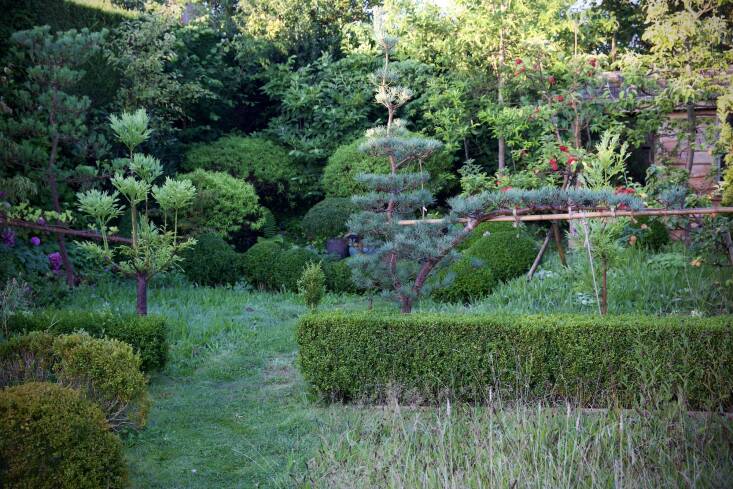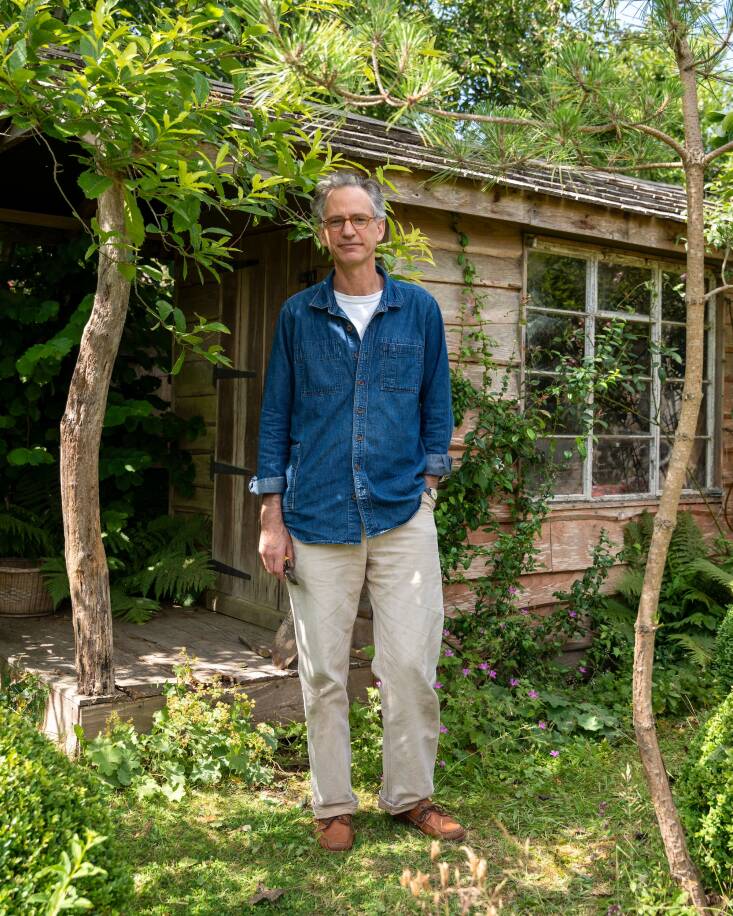Jake Hobson is a master pruner. He’s written two books on pruning: Niwaki: Pruning, Training, and Shaping Trees the Japanese Way and The Art of Creative Pruning: Inventive Ideas for Shaping Trees and Shrubs. And he’s the founder of Niwaki, a Japanese-inspired garden tool company headquartered in England. So, it should come as no surprise that his home landscape in Dorset is full of artfully shaped, precisely pruned shrubs and trees. But it isn’t your usual English garden with clipped hedges—nor is it a replica of Japanese gardens.
“Everything I do is inspired by Japan, but I’m deliberately not making it all Japanese,” explains Hobson. “There’s no koi pond or red bridges.” Not only does Hobson eschew any decorative Japanese elements, he avoids ornaments altogether. “For me, a Japanese garden is creating a sense of a landscape—an idealized landscape—within the plot. If you bring in ornaments, you ruin the magic of scale. Whereas, if all you’ve got is plants, you can create a sense (if you squint and after a couple of drinks) that maybe you’re looking out into a deep forest.”
Hobson has successfully created this illusion of landscape within his small space. Looking out the windows of the home he shares with his wife, Keiko, and their son, or gazing at photographs of Hobson’s green, layered garden, it’s hard to believe that it’s not much bigger than a tennis court.
When Hobson and his wife bought the house, the backyard had four sheds, a mismatched bunch of overgrown conifers, and a ton of concrete paths. They ripped it all out, leaving just the evergreen hedge that blocks the view from a neighboring building. Hobson commissioned a local carpenter to build a single new shed inspired by a Japanese “summer house” at the back of the plot. Then he planted dozens of evergreen and coniferous shrubs and trees that he has been training and pruning for the last fourteen years. The result is a garden that feels like its own miniature world, full of living sculptures.
Let’s take a tour of Hobson’s garden, which he photographed himself. (You can follow him on Instagram @niwakijake.)
Above: Every year Hobson lets the grass grow long and mows a new path through it. “Zigzagging through the garden is a really Japanese thing,” he notes. “You never just go straight into a house.” At right are some of Hobson’s undulating boxwood and a Phillyrea latifolia, which Hobson calls a “cloud-pruned tree.” (He had been growing it for years at his parents home before moving it to the garden.)
 Above: In recent years, Hobson has let this corner of cloud-pruned boxwood, a style which he helped to popularize in England, go a little more organic and blobby because he wanted it to be different from what everyone else is now doing. Hobson also notes that he loves the contrast of the clipped box against the mini meadow beyond.
Above: In recent years, Hobson has let this corner of cloud-pruned boxwood, a style which he helped to popularize in England, go a little more organic and blobby because he wanted it to be different from what everyone else is now doing. Hobson also notes that he loves the contrast of the clipped box against the mini meadow beyond.
 Above: A low, straight hedge divides the garden into two sections, a more ornamental section near the house and a wilder area at the back, which includes a mini orchard and some pine trees that Hobson has trained. “I felt I needed something a little bit more strong and straight and decisive because it was all lovely, bubbly, and sort of organic,” says Hobson of the dividing hedge.
Above: A low, straight hedge divides the garden into two sections, a more ornamental section near the house and a wilder area at the back, which includes a mini orchard and some pine trees that Hobson has trained. “I felt I needed something a little bit more strong and straight and decisive because it was all lovely, bubbly, and sort of organic,” says Hobson of the dividing hedge.
 Above: Throughout the garden are several Japanese cedar trees (Cryptomeria japonica, at left) pruned in an homage to the daisugi trees in Northern Kyoto. “For me, [it’s] the most exciting bit of the garden,” says Hobson, who appreciates how their strong vertical forms contrast with the horizontal, wavy shrubs. Traditionally grown for lumber, daisugi get chopped off to a stump from which new vertical branches re-sprout and are eventually harvested. (Hobson wrote extensively about daisugi in the first edition of Nawaki’s Field Report.)
Above: Throughout the garden are several Japanese cedar trees (Cryptomeria japonica, at left) pruned in an homage to the daisugi trees in Northern Kyoto. “For me, [it’s] the most exciting bit of the garden,” says Hobson, who appreciates how their strong vertical forms contrast with the horizontal, wavy shrubs. Traditionally grown for lumber, daisugi get chopped off to a stump from which new vertical branches re-sprout and are eventually harvested. (Hobson wrote extensively about daisugi in the first edition of Nawaki’s Field Report.)
 Above: Three years ago the Hobsons added an extension to the back of the house to create an office, so the adjacent portion of the garden had to be reimagined. Hobson planted some boxwood that will eventually get his artful pruning, but in the meantime, he’s sowing wildflowers to fill the gaps.
Above: Three years ago the Hobsons added an extension to the back of the house to create an office, so the adjacent portion of the garden had to be reimagined. Hobson planted some boxwood that will eventually get his artful pruning, but in the meantime, he’s sowing wildflowers to fill the gaps.
 Above: Referencing the cut stone used in many 20th-century Japanese gardens, Hobson repurposed some granite slabs from Niwaki’s Chelsea Flower Show trade stand as stepping stones within the new gravel patio outside the extension. “I’m 6’ 6”, I think I’m drawn to tall skinny things,” he jokes of their long narrow shapes.
Above: Referencing the cut stone used in many 20th-century Japanese gardens, Hobson repurposed some granite slabs from Niwaki’s Chelsea Flower Show trade stand as stepping stones within the new gravel patio outside the extension. “I’m 6’ 6”, I think I’m drawn to tall skinny things,” he jokes of their long narrow shapes.
 Above: Hobson stands outside of his summer house-inspired shed.
Above: Hobson stands outside of his summer house-inspired shed.
For more on Jake Hobson, see:





